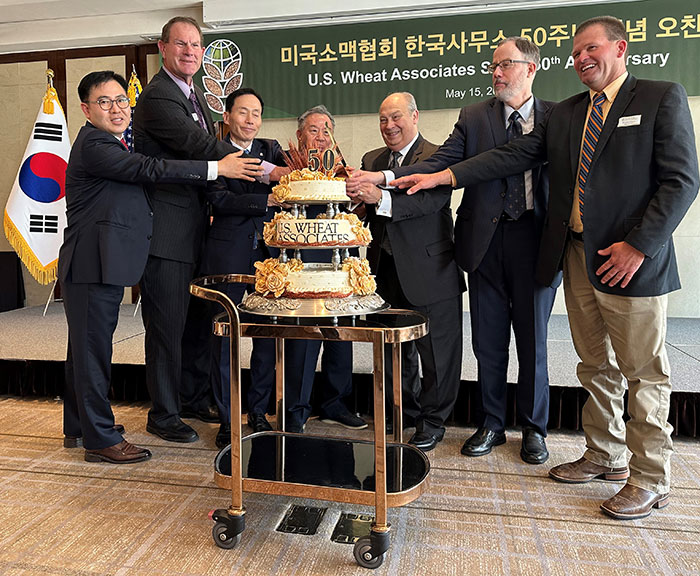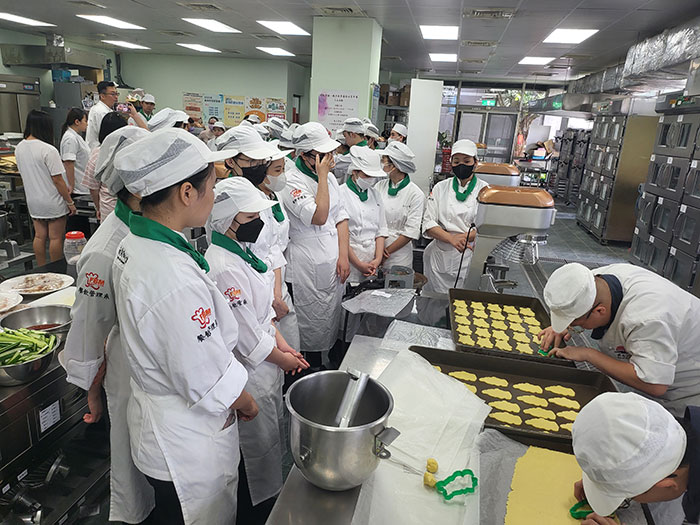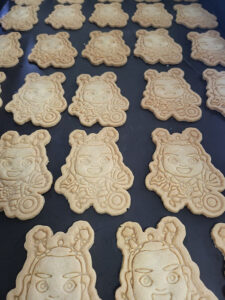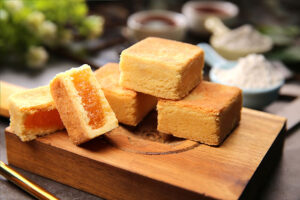Traditional North Asian US wheat markets remain steady, but still need support
By Steve Mercer
This is the third in a series of articles describing how U.S. Wheat Associates (USW) is investing funds from the Washington Grain Commission (WGC) to maintain and grow demand for soft white (SW) and other classes of U.S. wheat in overseas markets. The partnership between USW and state wheat checkoff programs allows USW to apply for export market development funding from U.S. Department of Agriculture’s (USDA) Foreign Agricultural Service programs.
That partnership has been working since the 1950s, yet ongoing export promotion remains vitally important to Pacific Northwest (PNW) wheat growers. For example, the U.S. exports an average of 55% of total annual SW production and carry-in stocks, and the percentage for Washington-grown SW is closer to 80%. From such products as sponge cakes, cookies, and pastries, to blending with other wheat classes, SW wheat flour has the versatility to improve the quality of a wide variety of products in the top SW export markets like Southeast Asia (May issue) and South America (June issue).
This article focuses on North Asian markets, specifically Japan, South Korea, and Taiwan. In marketing year 2023-24 that ended May 30, these countries purchased approximately 1.333 million metric tons (mmt), or 65.3 million bushels of SW that represented 29.5% of total U.S. SW sales.
USW’s legacy organization, Western Wheat Associates, originally opened these markets that remain strong trading partners with PNW wheat farmers. Yet, there are significant changes that require careful attention in trade service and technical support.

Japan
The Japanese market is very quality-conscious and sophisticated, making it a stable and consistent U.S. wheat buyer. For fine sponge cakes and biscuits (cookies), Japanese flour millers have imported Western White (WW) wheat (SW blended with minimum 20% white club wheat) through the Ministry of Agriculture, Forestry, and Fisheries (MAFF) for decades. In 2023-24, the U.S. exported 597,000 metric tons (mt), or 21.9 million bushels to Japan with an estimated total FOB value of $164 million, which is lower than the average prepandemic sales.
USW Japan Country Director Rick Nakano said the industry expects improving demand in 2024-25.
The market is mature with limited opportunities for growth due to an aging society and decreasing population. USW’s primary strategy, implemented by its oldest overseas office in Tokyo as well as the WGC, is defending SW and other U.S. wheat class sales.
Constant quality improvement is a crucial element that USW and WGC coordinate though an annual technical exchange with the Japan Flour Millers Association (JFMA). It involves JFMA analyzing the aptitude of various club wheat varieties for biscuit and sponge cake production and providing feedback to the WGC. Exchange results help inform the annual PNW Preferred Variety list and help SW and club wheat breeders incorporate Japanese preferences into new lines. WGC CEO Casey Chumrau participated in this exchange in June, with U.S. Department of Agriculture-Agricultural Research Service (USDA-ARS) Research Geneticist and club wheat breeder Kimberly Garland-Campbell, and USDA-ARS Western Wheat Quality Laboratory Director Sean Finnie.
“Another strong market for Western White wheat here is for biscuit production,” Nakano said. Wheat farmers from Oregon and Oklahoma joined U.S. Wheat Associates (USW) staff, officials from the Korean flour milling industry, and U.S. Department of Agriculture’s Foreign Agricultural Service in celebrating USW’s 50th anniversary of its office in Seoul in May 2023.
“When the Japan Biscuit Association created a consumption campaign, we saw an opportunity to be a partner in their effort to grow demand for products made with 90% Western White flour.”
USW Tokyo elevated U.S. WW in this industry by using Agricultural Trade Promotion (ATP) funding to help the association create and place articles promoting biscuits in the largest newspaper in Japan.
USW Tokyo maintains a regular schedule of trade team visits to the PNW for Japanese flour millers and trade service to all Japanese industry participants. Chumrau presented on SW and club wheat at the USW Japan Crop Update Seminar June 8-12, and the WGC will host its first of two USW Japan trade teams in Eastern Washington this August. Working with MAFF to help
officials adjust contract specifications based on conditions and customer needs is an important way USW and WGC fight to protect Japanese exports.
South Korea

In the Korean confectionery and baking industry, consumer preferences align with soft, mild textures and a preference for bright white flour. The industry produces increasingly sophisticated biscuits and cakes with 100% U.S. SW wheat. That is one of the reasons USW is expanding total demand by helping other markets like the Philippines adopt popular “K-Wave” wheat foods.
“For example, the demand for instant noodles produced in South Korea is growing rapidly, with exports to 132 countries setting a record in 2023,” said USW South Korea Country Director Channy Bae. “Instant noodle flour uses over 60% U.S. wheat, which includes a blend of soft white, hard red winter, and hard red spring.”
To grow demand, USW Seoul collaborates with customers to conduct an annual Noodle Flour Development Short Course at the Wheat Marketing Center (WMC) in Portland. Using WMC’s pilotcale noodle line to test U.S. wheat flour blends, customers have a better understanding of instant-fried noodle formulation, processing, and instant noodle ingredient functionality.
In the April 2024 short course, participants also visited an Oregon wheat farm.
In addition to conducting regular activities, USW Seoul plans to establish a baseline study of specific SW performance benefits compared to competitive suppliers.
Taiwan

Decades of work by farmers, USW, and USDA’s Foreign Agricultural Service export market development programs has established a preference for U.S. wheat in Taiwan’s milling and baking industry. This success is reflected in an 81% market share and annual sales of about 1 mmt, or 36.74 million bushels, including an average of almost 130,000 mt, or 4.78 million bushels of SW wheat. The strategy of helping Taiwanese customers develop new foods using U.S. wheat flour, which established demand for wheat foods and increased per capita wheat
consumption, remains relevant in a market nearing peak population.
 Recent examples include a June 2023 Classic Cookie and Snack Baking Workshop for nearly 40 food technologists, chefs, bakers, teachers, food bloggers, and students. The workshop demonstrated that, in the words of the university instructor, “Taiwan-made soft white flour is not only high in performance, but also a wholesome and cost-effective ingredient for cookies and cakes.”
Recent examples include a June 2023 Classic Cookie and Snack Baking Workshop for nearly 40 food technologists, chefs, bakers, teachers, food bloggers, and students. The workshop demonstrated that, in the words of the university instructor, “Taiwan-made soft white flour is not only high in performance, but also a wholesome and cost-effective ingredient for cookies and cakes.”
“The popularity of traditional religion and culture, including food, is growing,” said USW Taiwan Country Director Yi-I Huang. “To link U.S. wheat flour with this trend, we collaborated with a technical school and a large food company to conduct a traditional pastry baking workshop for a range of participants.”

The workshop demonstrated pastries made with SW flour, such as “Patron Saint of Children” cookies. Other pastries depicted the Chinese “Mazu” goddess of the sea and linked to an annual Mazu pilgrimage parade in which more than 4 million people participated in 2024. In addition, the workshop emphasized the wholesomeness of the products. The manager of a day care center that participated told USW, “I’ll use the U.S. wheat flour made in Taiwan to create more healthy products without food additives for our kids.”
This article originally appeared in the August 2024 issue of Wheat Life Magazine.

Steve Mercer
Steve Mercer is the vice president for communications for the U.S. Wheat Associates and a contributing author to Wheat Life Magazine.
